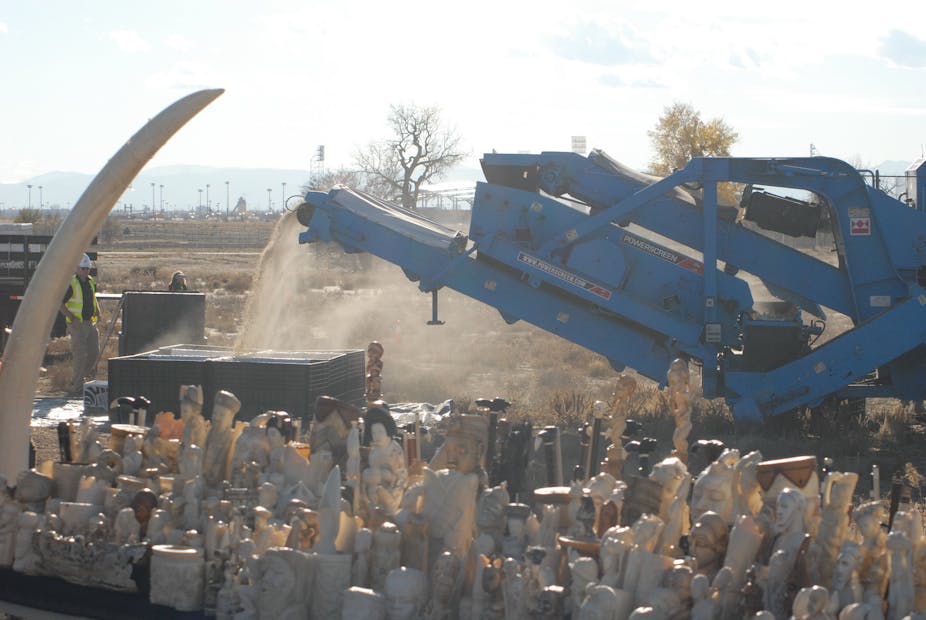Confiscated ivory taken from smugglers, traders and tourists by US authorities was crushed to chippings last week, The stockpile of more than six tonnes, amassed since the 1989 international embargo on the ivory trade came into effect, had an estimated value of US$10 billion.
In terms of publicity stunts this was a good one. But it will be about as effective as other similar stunts that vainly sought to contribute to the end of pernicious societal phenomena through very public displays – burning cocaine, crushing firearms, even burning literature deemed “offensive”.
As an economist with a close and abiding interest in preventing the extinction of elephants, rhinos and tigers I find the arguments for this latest stunt to be, at best, breathtakingly naïve. At worst, it is a cynical attempt to preach to the converted to secure their votes, funds and goodwill.
Capturing the moral high ground is all well and good, but stealing attention and headlines from much more laudable and practical approaches to the problem is counterproductive. As far as I can see, the case for destruction rests on a number of largely fatuous arguments.
For example Dan Ashe, Director of the US Fish and Wildlife Service should know better when he says “These stockpiles of ivory fuel the demand,” and “keeping the stockpile could feed consumer demand for illegal souvenirs and trinkets”. I can’t explain the economic thinking behind this statement, unless he was suggesting that the US government intended to reduce demand by selling the ivory goods it crushed. Possibly a good idea if one considers that $10 billion would go a long way to funding community conservation efforts in poor source countries in Africa .

He is not the only economically-challenged policy maker involved. Secretary of State John Kerry, no less, also spuriously declared that crushing ivory would in some way affect the profits of criminals, and event hinted that it would help end the drugs and arms trades when he said that profits from wildlife trafficking were pumped into other illicit activities such as narcotics, arms, and human trafficking.
Economic reasoning contradicts this, as destroying stockpiles generally leads to price inflation and higher profits because expectations about future supply are downgraded.
The principal reason that the ivory trade is now firmly in the hands of criminal gangs is the aggressive enforcement of the international and domestic trade. This has played into the hands of criminal networks that have the connections, resources and expertise as clandestine traders of other illegal goods to avoid capture and punishment.
The most frequently cited reason to destroy stockpiles seems to be to “send a message”. For example, according to Savetherhino.org it is “time to make a bold and very public statement in order to protect rhinos.” A message to whom, exactly? Surely no one can be naïve enough to imagine that serious criminal masterminds will be deflected from their pursuit of profits by such messages? Perhaps then it is a message directed to others – the “true believers” who largely reside in the US and Western Europe and believe the trade is evil. Forgive my cynicism, but is preaching to the converted not a well established ruse to secure votes and/or cash donations?
I am in no doubt that the illegal trade in ivory threatens the very existence of the African elephant, the largest land animal on Earth. But I believe we must respond to this situation with carefully reasoned and mature policies that are supported with adequate financial resources.
Against a backdrop of rising prices for ivory and horn and therefore rising incentives to rhino and elephant, our interventions need to go beyond regulation. We need to incorporate new and bold strategies that reflect the complexities of governing international trade, and the role that poverty plays in the powerful market dynamics of illegal products.
In the same way that more realistic approaches are beginning to emerge in tackling other international problems such as drug trafficking, it’s imperative that conservationists stop promoting publicity stunts just because they appeal to their own personal beliefs. Instead they should focus on policies and strategies that will reduce demand for illegal wildlife products, and increase the opportunity costs of poaching – chiefly by tackling rural poverty.
If we are to win this battle, we must reduce demand for illegal wildlife products from Asia through social marketing programmes that target key consumer groups such as business people and political leaders, designing incentives for local communities to protect and conserve the wildlife around them, and build global capacity to manage a legal trade sustainably trade sustainably, that might need to include wildlife ranching and farming, or using economic levers such as taxation of wildlife products to fund conservation efforts.
Implementing some of these measures will not be easy and will require considerable political courage. But these are the first steps essential to preventing the extinction of some of the world’s most valued species.

